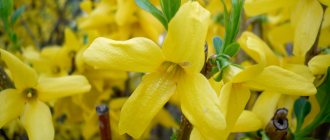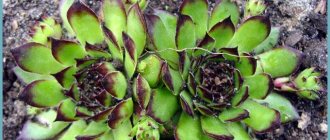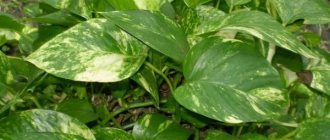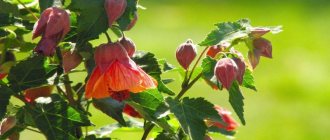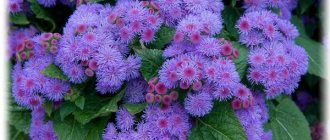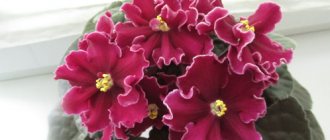- October 10, 2019
- Flowers
- Michael Michaelis
Flowers that look like bells are very popular among landscape designers. This is due not only to its decorative qualities, but also to its ease of care. In our article you will find not only a detailed description of plants with bell-shaped flowers, but also rules for caring for ornamental crops. In addition, all the information is supplemented with real photographs, so it will not be difficult for you to choose a variety that will look perfect in your yard.
Lilies of the valley - decorative and unpretentious
May lily of the valley is a herbaceous plant from the Asparagus family, which is listed in the Red Book. The culture is quite low (up to 30 centimeters in height), but has a rather beautiful appearance. Also a distinctive feature of all lilies of the valley is their thin, long, creeping rhizome with numerous shoots. At the base of the plant there are pale leaves that go well with the pale flowers.
The May lily of the valley has 6 to 20 pale yellow flowers that look very similar to bells. The largest buds are located at the base of the inflorescence, since there they receive more nutrients than those located at the top. The flowering period is from May to June. Closer to summer, rather large fruits (8 millimeters) ripen, containing from one to two large seeds.
Lily of the valley prefers to grow in regions with a temperate climate. However, if you create good conditions for it (shade and moisture), then it can be grown in the south. As for the soil, the plant prefers soil with average acidity. Air temperature can vary from 5 to 25 degrees Celsius. It is thanks to their unpretentiousness that lilies of the valley are very popular among plant lovers.
What are the names of flowers that look like bells?
The bellflower itself is a herbaceous plant of the Campanulaceae family. Although this flower is more classified as wild, it is also successfully grown in gardens. In addition, there are many plants that are similar in appearance and have a dome-shaped flower. These include representatives of the Bubenchikov and Ostrovsky clans. Some species of the Gentian family can also be added here.
Brugmansia
Brugmansia is a very unusual shrubby plant with a tree-like trunk, known in the literature as the “stupefying tree”. It is popularly referred to as "angel's trumpets" because of its beautiful hanging flowers.
Brugmansia is grown as an ornamental plant in the Caucasus and the Crimean coast; in other regions it is not widespread, since it is heat-loving and may not survive the winter in colder climates. In nature, it can only be found in South America.
Brugmansia, despite its beautiful flowers, is a poisonous plant
The decorative species of Brugmansia reaches a height of no more than 2 m, in contrast to the wild one, which can grow up to 5 m. The flowers are shaped more like a “gramophone”, 20-30 cm long and up to 15 cm in diameter. Their color can be yellow, pink or white, and there are also options with a gradient color. The aroma is pleasant and is especially noticeable in the evening.
Hyacinthoides
Hyacinthoides is a tall flower that looks like a bell. It is also called wild hyacinth. Under natural conditions it is found in almost any area (in forests, fields, steppes); it is also often planted in gardens and personal plots.
Hyacinthoides is an early flowering plant that pleases with its flowering throughout the month.
The flower itself is a bulbous perennial that is easy to care for. It reaches a height of up to 50 cm, the peduncle is single and can be from 30 to 40 cm. The leaf blades are located next to the root and are up to 30 cm long. The flowers are small, up to 2.5 cm in diameter, tubular-bell-shaped, drooping , there are 4-10 buds in a group. Their color can be white, pink, lilac or blue.
Adenophora
Adenophora also belongs to the tall counterparts of the bell, and is also its close relative. This flower is popularly referred to as “Bell”.
Adenophora, unlike the bell, has a longer pistil
The herbaceous plant Adenophora can reach a length of up to 1.5 m. The root system is taprooted, quite powerful, capable of penetrating deep into the soil. The stem is erect, the green mass is whorled. The flowers are funnel-shaped or bell-shaped, the color is classic: purple, blue and white. The buds are collected in racemes or paniculate inflorescences.
Attention! In addition to its beautiful appearance, Adenophore is also valued for its medicinal properties.
Datura
Datura is a white flower that looks like a bell. The plant is an annual plant with beautiful large buds and begins to bloom from June to September.
Datura, despite its beautiful inflorescences, has an unpleasant intoxicating aroma
The plant is more classified as a weed, as its toxicity scares away gardeners. The stem is straight, forked-branched in the upper part. The leaves are medium in size, ovoid in shape with uneven teeth along the edges. The flowers are quite large, tubular-funnel-shaped, located one at a time in the forks of the stem.
Attention! Datura flower is also called nocturnal, as the bud begins to open at sunset.
Codonopsis
Codonopsis is a climbing perennial that can decorate a fence or fence well. The garden flower itself is similar to a bell only in the shape of the bud.
Codonopsis, after planting in open ground, blooms in the first year of life.
The stems of the plant are bare, climbing and quite long; they can grow up to 2 m in length. The main root is radish-shaped, the system itself is powerful and well developed. The leaf blades are sessile, large, broadly lanceolate, up to 8 cm in length.
The flower is single, apical and has a different color depending on the variety (sometimes bluish-green, slightly yellow with a purple edge). The aroma during flowering is unpleasant.
Aquilegia
Aquilegia, also popularly known as "eagle", "boots" or "columbine", belongs to the Buttercup family. In nature, there are about 120 species of this plant, of which only 35 are grown as an ornamental crop.
In gardens, aqualegia is cultivated mainly of hybrid varieties
Attention! Depending on the type, the plant may have different parameters, including the color of the buds and the height of the bushes themselves. But, regardless of this, the flower has a light, pleasant aroma and, unlike the bell, has a more complex bud shape.
Digitalis
Foxglove is a very impressive-sized plant that grows to its full height in the second year of life. Initially, after planting in open ground in the first year, the seedlings will be low, no more than 30 cm, after which this figure will triple, reaching 1.3-1.5 m.
Foxglove stems are very rigid with virtually no side shoots.
The leaf plates are quite large with a relief surface. The leaf is glossy on top and has a thick, fleecy coating on the back.
The peduncle is presented in the form of a brush of collected large bell buds, the color of which can be white, purple or pink with clearly visible specks inside.
Galanthus
Galanthus, also called "snowdrop", belongs to the Amaryllis family. It is a perennial bulbous plant, the peculiarity of which is its early appearance and flowering.
Under natural conditions, galanthus can be found along river banks, on forest edges and in meadows.
Galanthus is a white flower, similar to a bell, has thin long leaf plates and, at first glance, a fragile stem no more than 15 cm in height. Despite this, it is considered quite hardy and unpretentious. Galanthus blooms immediately after the snow melts, approximately in February-March.
Important! All types of galanthus are protected, some of them are considered endangered.
Grouse
The hazel grouse is another peculiar double of the bell, the scientific name of which is Fritillaria, which belongs to the Liliaceae family.
Because of its unique appearance, the hazel grouse is also called the “tree of paradise.”
Of all the varietal diversity, the imperial hazel grouse has the most attractive appearance. The stem of this plant is thick, the flowers are single or collected in a brush in the form of an umbrella. Thin, oblong leaves rise above the inflorescence.
Cyananthus
Cyananthus is a blue or pale blue flower that not only looks like a bell, but also belongs to this family. It is not very common as a garden crop.
Cyananthus can be considered the shortest representative of the Bellflower family
This plant is characterized by small shoots that grow 30-40 cm. The leaf blades are small, narrowed at the base and pointed at the top. Over the summer, the leaves change color from green to white.
Attention! Cyananthus is not afraid of cold weather and can easily withstand temperatures of -15 °C, but these flowers tolerate dry and hot weather very poorly.
Gentian
Gentian is another blue flower that looks like a bell. It belongs to the Gentian family. In total, there are about 400 species in nature, 90 of which are found in selection.
Wild gentian species differ significantly from garden ones not only in parameters, but also in flowering time
The root system is shallow, the stems are erect and usually short. Flowers, depending on the variety, can be single or collected in a group at the top of the stem. In addition to the blue, light blue and white colors of the buds, you can also find yellow flowers.
Wide bell
Another interesting flower that looks like a bell is the broad bell, also called platycodon. It is represented by a small, up to 60 cm in height, lush bush with decorative green mass.
Broadbell flowers are considered its main feature
The plant is late flowering, perennial and very decorative. Its buds have an unusual shape, which, when they reach 8 cm, transforms into a round cup. The color palette is varied, ranging from light blue to pink.
Kobeya
Kobeya is a bush climbing flower, similar to a bell, belongs to the Sinyukhov family. The length of its stems can reach up to 6 m in length and even more. The leaves are compound pinnate, trilobed, arranged alternately on the stem. At the ends of the shoots they transform into tendrils, allowing the plant to securely anchor itself to the support.
Kobeya as an ornamental flower is grown as an annual
The flowers are quite large (8 cm in diameter) in the form of bells. Stamens and pistils are strongly protruding. The buds grow singly or in groups of 2-3 pieces; they are located on long peduncles growing from the axils of the leaves.
Gloxinia
An interesting and very beautiful indoor flower, similar to a bell, is called Gloxinia. It belongs to the Gesnerieceae family, and is a tuberous perennial.
Most gloxinia species are presented in two-color colors.
The flower itself has short shoots and fairly large leaf plates of a rich green color. The surface of the leaves, like the buds, is velvety. The flowers are bell-shaped, 7 cm in diameter and about 5 cm long.
Symphiandra
Symphiandra is a little-known, but very similar to the bells, herbaceous plant, which, despite the fact that it is a perennial, is grown in gardens as a biennial.
All types of Symphiandra are suitable for growing for decorative purposes on rocky soil
The bush is tall and spreading, reaching about 60 cm in height. The leaf blades have a slightly elongated shape and are sparsely spaced. The inflorescences are drooping, collected in spike-shaped racemes. The buds are medium in size, light in color.
Lobelia
Lobelia is a home garden flower that only slightly resembles a bell when you look closely at the shape of the inflorescences.
The color of lobelia flowers directly depends on the variety
Under natural conditions, lobelia grows as a perennial shrub, but in gardens it is grown mostly as an annual. The plant itself is a compact spherical bush of small size, not exceeding 20 cm in height. The shoots are very thin and begin to branch at the base. The leaves are arranged alternately and are small in size. The flowers are two-lipped axillary, about 2 cm in diameter.
Ostrovsky
Ostrovsky is a very unusual representative of the Kolokolchikov family, listed in the Red Book. The plant is rarely cultivated in gardens, as it is slow-growing.
After seed germination, Ostrovsky blooms in 4-5 years.
Ostrovsky has a bare stem that grows up to 1-1.8 m in length. The leaves are oblong-ovate, arranged in whorls of 2-5 pieces. in each. The inflorescence has the appearance of a panicle, in which up to 30 large white or light blue flowers are collected on a long peduncle.
Eustoma
Eustoma is a very attractive flower with purple or bicolor flowers, similar to mina bells.
When unopened, eustoma buds are similar to roses, and their oblong shape resembles bells
Plants reach up to 30 cm in height, and some indoor species can even grow up to 70 cm. The stems are powerful and branched from the middle, so the bush seems voluminous. The leaves are glaucous, with a smooth, waxy surface. The flowers are simple or double, sometimes reaching up to 8 cm in diameter.
Features of growing lilies of the valley
If you want to grow these flowers in the form of bells, then you will need to create optimal conditions for them, which have already been described just above. Further care is not difficult - you just need to make sure that the soil is always moist and the sun does not burn the delicate petals of the grass. However, even if these conditions are not met, the flower is unlikely to die, since it has fairly good resistance to drought.
However, there are still some peculiarities regarding the care of lilies of the valley. Firstly, the soil will have to be constantly fertilized with compost or rotted manure, since lilies of the valley need a large amount of microelements. The same applies to mineral fertilizers. They are worn for the first time in August, after which - at the end of the flowering period. Particular attention should be paid to the nitrogen and potassium content in the soil.
Adenophora
Adenophora is a close relative of the bell, which is easy to guess from its popular name - bell.
Latest articles about gardening
This herbaceous perennial is unpretentious, can grow in both sun and partial shade, is undemanding to the type of soil, and does not require shelter for the winter. Keep in mind that adenophora needs good soil drainage and does not grow well in acidic soils.
Bellflower blooms most of the summer. Easily propagated by seeds. In this case, winter sowing is preferable. If you did not have time to sow bells in late autumn and plan to sow in the spring, it is advisable to stratify them for a month (keep them in the refrigerator).
Foxglove - beauty and ease of care
Perennial foxglove is a herbaceous plant from the Plantain family. Translated from Latin, the name of this culture means “thimble”. The flower received this name due to the unusual shape of the corollas. However, do not forget that the genus has about 35 different varieties, which differ not only in the shades and shape of the inflorescences, but also in the characteristics of care.
In nature, you can find plants in the form of shrubs and subshrubs, the size of which ranges from 30 to 150 centimeters. A distinctive feature of this crop is its very rigid (for grass) stem with pointed tips, thanks to which the plant can withstand the weight of a huge number of bell-shaped flowers. Most varieties grown in Russia are white or pink.
Carpathian bluebell (Campanula carpatica)
The most common cultivated plant in Russia is the low bell. He comes from Central Europe (Carpathians).
Bluebell Carpathian
Its parameters: height up to 30 cm, width 30-60 cm. The leaves in the basal rosette are long-petiolate, ovate-rounded, up to 5 cm long. The flowers are large, bell-shaped, blue, violet-purple, white, with a diameter of 3-5 cm. Flowering is very abundant, in summer.
Decorative varieties and forms:
- 'Bressingham White' - large, white flowers;
Bluebell Carpathian 'Bressingham White'
- 'Jewel' - compact, 10-15 cm high, purple-blue flowers;
Carpathian bell Jewel. Photo from chto-posadit.ru
- 'Turbinata' - dwarf (10-15 cm high), lavender-blue flowers;
Bluebell Carpathian 'Turbinata'. Photo from alpine-seeds.com
- 'Weisse Clips' (syn. 'White Clips') - 20 cm high, white flowers.
Bluebell Carpathian 'White Clips'.
Photo from the site 7.allegroimg.com Forms dense cushion-shaped turf.
Features of growing foxgloves
Perennial foxglove is grown exclusively from seeds, which have a fairly good germination rate. However, in order to acquire a large number of ornamental plants, you will have to prepare a substrate in advance in which they will feel comfortable. Since in nature this crop grows mainly in deciduous forests, a mixture made up of an equal amount of peat and turf soil is ideal.
It is recommended to grow seedlings in a warm room, constantly maintaining optimal soil moisture. As soon as the first shoots hatch, they can begin to be exposed to the street for several hours, carrying out the hardening procedure. 2-3 weeks after germination, the plant is planted in open ground in an area that is well lit. All that is required from the gardener in the future is to monitor the condition of the soil.
It's not just about regular moisturizing, but also about keeping away weeds. Perennial foxglove has an extremely negative attitude towards most types of pests, which suck not only moisture from the soil, but also useful microelements. Also, the substrate must be loosened from time to time so that the root system does not experience oxygen deficiency. It is also recommended to fertilize the plant once a year with organic and mineral fertilizers.
Pests and diseases
In comfortable conditions, a tropical flower rarely gets sick. Dense pubescence repels most harmful insects. But koleria can become infected from other plants or react painfully to violations of the rules of care.
Main diseases - table
| Disease/pest | Signs | Prevention | Control measures |
| Root rot | Lethargy of leaves and stems. The roots become soft and rotten. | Root rotting occurs due to dense substrate and excessive watering. The soil should not be over-moistened. |
|
| Whitefly | A coating appears on the leaves and stems, the affected areas begin to rot, and growth stops. | Inspect the plant for the presence of parasites, provide access to fresh air. |
|
| Cyclamen mite | When attacked by a mite, the buds wither and fall off, the stems curl, and plant growth stops. | Do not create an overly humid microclimate. |
|
| Aphid | A small insect sucks the juices out of the plant, the leaves wither and curl, and the shoots dry out. | Inspect the flower garden regularly. Monitor the temperature and ventilate the room. |
|
Photo gallery - diseases and pests of Koleria
The fact that a whitefly has settled on the plant is evidenced by a coating on the leaves.
Aphids, feeding on plant sap, cause shoots to dry out. Overmoistening of the soil leads to root rot.
When affected by the cyclamen mite, the buds wither and fall off
Brugmansia - exotic and large sizes
Can’t remember the name of a bell-shaped flower that looks a lot like a tree? Perhaps we are talking about Brugmansia from the nightshade family? Another name for the culture is “intoxicating tree.” It received such an unusual name due to the fact that its petals contain a strong intoxicating substance, which is used by some traditional healers for medicinal purposes.
This plant is suitable for growing in regions with mild winters, as it does not tolerate frost. However, one cannot help but note the fact that breeders are still developing new varieties that differ in their care. In addition, some varieties are even grown as houseplants. Although in this case the bush will not be able to show all its splendor without reaching a height of 150-200 centimeters.
“Angel trumpets” (as the flowers of the plant are popularly called) are distinguished by their unusual appearance, which resembles a bell enlarged several times. Their number on one plant can reach 100 pieces, which makes Brugmansia one of the best options for decorating gardens. The main drawback is that the culture is quite demanding in terms of care. In the spring and summer, you will have to shape the tree crown almost weekly.
Campanula, popularly “bride and groom”
Nature is generous with gifts: mighty trees, lush shrubs, graceful flowers. But, perhaps, none of them carries as much positivity, love of life and joy as the campanula. It’s not for nothing that this elegant beauty is called the flower of family happiness.
Another name for a campanula is the bride and groom. White flowers are brides, blue flowers are grooms. The indoor flower belongs to the bell family and has been known to mankind since ancient times. Reproduction and care of campanula at home is not difficult.
In the wild it grows in areas with a temperate climate: in Central Asia and some European countries, in the Caucasus, in some places in North America and Siberia. Prefers rocky and desert areas, alpine meadows, steppe and forested areas.
Campanula is translated from Latin as bell, and for good reason: its many flowers resemble bells. This is a creeping hanging plant, the shoots of which rarely reach 50 cm. The flowers can be colored either white or purple. The diameter of the inflorescence is 3-4 cm. The leaves are light green, heart-shaped, slightly rounded.
Types and varieties with photos
Campanula lends itself well to selection, so today, as a result of numerous experiments, many varieties of inflorescences have been bred: double or with wavy edges, with fringed edges, large-leaved and small .
Blueberry, birdbird, bell, chebotok, Star of Bethlehem - these are the nicknames given to campanula by the people.
Below are descriptions and photos of Campanula varieties suitable for propagation and care at home.
Equal leaf or Isophylla
The species diversity of Campanula is great - more than 400 species - but it is the equal-leaved Campanula (Campanula isophylla) that is grown at home more often than others.
The shape is ampelous and does not exceed 30 cm in height. Since numerous flowers weigh down the stems, you should choose a hanging pot of a suitable size. Flowering period is spring and summer.
The photo below shows Campanula Equalifolia:
Terry
Campanula terry is a tiny bush (no more than 15 cm in height), strewn with numerous flowers of all shades of blue and white. Appeared by crossing the spoon-leaved and Carpathian species.
Petals in the form of stars are collected in graceful inflorescences growing at the ends of the shoots . The color palette is varied: all shades of white, blue, lilac and dark blue.
The leaves are bright, juicy, have jagged edges, have a rounded heart-shaped shape and long petioles. The stems are flexible, creating a kind of “cushion” 20 cm or more in height.
You can see what the Campanula Terry variety looks like at home in the photo below:
And this is the Terry campanula in the open ground:
Bicolor
- Berlin Bicolor is a spectacular variety whose flowers are distinguished by unusual colors: the edges of the petals are lavender-blue, and the center is boiling white.
- Old Bicolor Star (Starina Bicolor Star) - looks similar to Berlin Bicolor, but the petals are colored not lavender, but blue.
- Dublin Bicolor is a new variety developed just a few years ago. Rarely found on sale, even in specialized stores. The flowers are star-shaped, the center is white, the corolla is blue.
The photo below shows a flower of the Campanula Bicolor variety:
Care
Indoor campanula flower: subtleties of care at home.
After the purchase
The first thing you need to do is check for new shoots without buds, the absence of dry leaves and pests. Carry out this check not after, but before the purchase, by carefully inspecting the plant in the store.
If you bring campanula home and place it in the chosen place, then within a week you will watch it dry out. Therefore, be sure to transplant the plant into a new pot, and not just by moving the bush, but by removing all the old soil in which it grew.
I keep the campanula in quarantine for the first week , i.e. do not place it in a common corner with plants, but put it in another room, in partial shade.
Observe: will pests appear on the leaves during this period, will larvae crawl out to the surface of the soil?
Pot
Campanula can be grown in flowerpots, tall flowerpots, or regular pots. Perhaps, it is the stems hanging down that emphasize the beauty of the campanula, so choose a flower pot if possible.
The first pot should not be too deep and wide, but on the contrary – too cramped. Let the roots of the campanula weave more closely into the earthen ball. But choose subsequent containers 1-2 centimeters wider than the previous ones.
Both plastic and ceramic pots have both advantages and disadvantages.
Plastic ones last much longer, rarely break, and the variety of colors allows you to choose a container to suit any interior, which is often of considerable importance for the gardener.
However, the big “minus” of plastic is that it overheats. And this can have a very negative effect on the root system.
Clay pots do not overheat in the sun and allow air to pass through well (except for those covered with glaze). However, moisture quickly evaporates from them, and they break easily. Do not buy polystyrene pots - they are very unstable and will begin to tip over as soon as the campanula grows a little. Choose a flowerpot in the form of a hanging basket.
Priming
Buy a substrate for flowering indoor plants: it is loose and allows oxygen to pass well to the roots. You can make it yourself . Mix leaf and peat soil and coarse sand in equal parts. Don't forget to add expanded clay, small pebbles or broken bricks for drainage.
All components, like the store-bought substrate, must be treated against pests. Even if you are sure that they are not there, this will not harm either the campanula or the soil, and will add peace of mind.
You can calcine the soil in the oven for half an hour, freeze it for two days in the freezer, treat it with a weak solution of potassium permanganate or biological fungicides (“Planzir”, “Zaslon”, “Fitop”, “Integral”, “Agat”, “Fitosporin”, “ Barrier").
Lighting
Campanula is a light-loving plant, but direct rays of the sun are contraindicated for it.
By placing the plant on or near the western and eastern windows, you can't go wrong . In the south it will be too hot, in the north there will not be enough light.
If there are no other options except the last ones, organize artificial lighting using a fluorescent or phytolamp, hang thick curtains or put up a paper screen.
On warm spring days and summer, take the campanula to an open balcony or garden - such a walk will benefit the plant. At the end of September, with the arrival of autumn coolness, such trips stop.
An amazing observation: campanula flowers always turn towards the sunlight. However, you should not sharply turn the pot towards the light: this will have a bad effect on flowering. Do this a little bit every day.
Temperature
Suitable temperature for bells: in summer - +22-25 degrees, in winter + 15 degrees. Withstands small temperature fluctuations.
Campanula is not afraid of a small warm breeze , but it cannot stand cold drafts. If you choose a window sill for wintering your pet, check that there are no gaps in the frames. When ventilating the room, take the indoor plant to another room.
Humidity and watering
Campanula loves water, so don’t skimp on moisture. In summer, water the plant every day (on hot days - twice a day) - don’t be afraid, you won’t flood it. In winter, reduce watering, allowing the top layer to dry thoroughly. In spring and autumn, bluebells can easily withstand a slight drought of 1-2 weeks.
Pre-settle tap water by pouring it into a pan and leaving it for a day without a lid. This will remove chlorine, excess salts and other harmful impurities from the liquid. You can use a household filter for cleaning.
Campanula needs high air humidity , so spray it with warm water often and wipe the leaves with a damp cloth. By doing this you will not only clean the plant from dust, but also allow the leaves to “breathe”.
How to replant?
The root system of Campanula is powerful and grows so quickly that it occupies the entire pot in a short time. Therefore, transplants should be carried out every spring.
Choose larger containers: for a small-looking plant - 3 or even 5 liters. Planned transplantation, the same as after purchase - by transshipment method.
Don't forget about the drainage layer! After the procedure, the soil is compacted with hands and watered abundantly.
Some are afraid to plant the “groom” and “bride” side by side, believing that they may cross-pollinate. Nothing bad will happen, and they will look much more impressive together.
Top dressing
It is necessary to feed Campanula during the period of active growth. Do this once every 10 days with complex mineral fertilizer. There is no need to do this during the rest period.
Bush formation
If you want to admire the cap bloom , start forming a bush.
Trim all dried stems and flowers, side shoots and top leaves, and bare tips of shoots, making them approximately the same length. The shoots growing from the axils will be of the same age and will begin to bloom “caps”.
Pruning and care after flowering
Hygienic pruning of campanula after flowering is not necessary, but desirable. It is carried out in the same way as the formation of a bush, not only in spring, but also in autumn.
Rest period
The dormant period lasts from October to December.
At this time, you should reduce watering as much as possible (to eliminate the risk of stagnation of water in the pot), lower the temperature in the room, carry out additional lighting every day and do a little pruning (leaving shoots 10 cm long with a couple of buds). If before this you properly cared for the plant, by the New Year holidays the campanula will delight you with repeated flowering.
Planting by seeds
- Seeds should be planted in the ground in the spring. Pre-soak them in a weak solution of potassium permanganate or “Kornevin”.
- Pour the soil into a plastic cup, moisten it, pour dry soil on top, sow the seeds and sprinkle with water. Cover with film and place in a warm, well-lit place.
- When 3-4 leaves appear, transplant into flowerpots.
Dividing the bush
The most reliable and easiest way to propagate a plant. In the spring, when the campanula begins to actively grow, remove the bush from the pot, carefully cut the earthen lump in half and plant the halves in different pots. The rest of the care is as usual.
Reproduction by cuttings
- Use a sharp, disinfected blade to cut off shoots with a few healthy leaves.
- Place them in a weak solution of potassium permanganate for 10-12 hours.
- When the roots appear, transfer them to a container with clean water for a couple of hours, and then plant them in a container with a substrate (a mixture of peat and river sand).
Depth - no more than 3 cm. Cover the container with cling film, creating a greenhouse effect, spray and ventilate the seedlings daily. - As soon as the root system becomes strong, plant the cuttings in permanent pots.
Indoor campanula: how to plant, grow and provide care at home.
Pests and diseases
- What to do if Campanula dries out? If the leaves of your flower dry out, turn yellow or lose their brightness, move it to another place. Most likely, the plant is receiving too much light.
- If the stems become thin and quickly grow in length, on the contrary, there is not enough light. Turn on the phytolamp for 5-6 hours a day.
- Limp, soft-to-touch foliage indicates overwatering.
- Gray rot is determined by the appearance of gray spots and black dots on the leaves of Campanula. Cut off the damaged parts, treat the cut areas with crushed activated carbon, and soak the root system in a solution of potassium permanganate (pale pink) or fungicide for half an hour. The same procedure applies to root rot.
Spider mites and scale insects often attack campanula, so keep insecticides in stock : Aktara, Metaphos, Fitoverm, Permethrin. But first: wash the plant in the shower (covering the pot with plastic so that the soil does not become sour). Afterwards, place the flower in a plastic bag, sprinkle the inside with the preparation and, after tying, leave for half an hour.
After which the plant is washed again. The procedure should be repeated after a week.
If the pests have not yet invaded your flower, try using a folk remedy. For example, mix 15 ml of soap shavings, 10 ml of alcohol and 1 liter of boiling water, beat the mixture until foamy and treat the plant.
Signs and superstitions
It is believed that you should buy campanula for growing in the house in pairs, planting both the “groom” and the “bride” in the same pot so that they generate positive energy for the home.
Gentle bells know how to absorb other people's negative influence , prevent quarrels and help cope with stressful situations. The bride and groom give harmony to the home and have a calming effect on the nervous system.
It is recommended to give campanula to newlyweds as a wedding gift, and couples who want to have a child should put a pot with the plant in the bedroom. If you take good care of the plant, and it suddenly dies, it means that your campanula has received damage aimed at you. Thank the flower for its help and bury it in nature.
Features of cultivation
The Brugmansia flower is highly demanding in care. For example, as mentioned earlier, he prefers regions with a temperate climate, where the air temperature is from 22 to 25 degrees. However, if this indicator is exceeded by at least 10 degrees, the plant will begin to experience severe discomfort - it will gradually begin to shed its bells, and the leaves will rapidly fade.
High-quality watering is also of great importance in care. In the summer, the tree needs quite large volumes of water. And not just any liquid will do. Most professional gardeners recommend using rain or well-settled water that does not contain harmful impurities. But in the spring you will have to irrigate the crop extremely carefully, since excess moisture will immediately lead to the development of root rot.
Brugmansia also needs regular pruning, especially if the gardener wants to form a really beautiful crown. This procedure allows not only to improve the decorative qualities of the plant, but also to speed up the onset of the flowering period. With proper care, the beauty of this tree will be simply indescribable. However, due to the fact that not every gardener can grow such a complex crop, Brugmansia is not very popular.
Reproduction
Koleria is propagated by seeds, cuttings and rhizomes.
Propagation by seeds
Seeds are sown in January. Since they germinate in bright light, they are distributed superficially, without sprinkling.
- Seeds are placed in a container with moistened peat and sand.
- Cover with transparent film and keep warm.
- Ventilate, remove condensation, moisturize.
- Seed germination takes several weeks.
- Shoots dive according to the pattern 1x2 cm.
- A month later, a second pick of 3x3 cm is carried out.
- Grown seedlings are planted in containers and given normal care.
Grown seedlings are transplanted into separate pots
Leaf propagation
The most common propagation method is vegetative: by leaves and cuttings.
Select a healthy leaf with a juicy petiole, make a cut and lower it shallowly into water. Cover with film. When callus (a growth from which roots then grow) is formed, it is planted in the ground under a greenhouse. It is necessary to maintain the air temperature +23–25°C.
After callus has formed, the leaf cuttings are planted in the ground under a greenhouse.
Sometimes the leaf is immediately planted at an angle of 45 degrees in moist, loose peat soil to a depth of 5 mm and placed in a mini-greenhouse. Ventilate regularly and remove condensation. Rooting lasts 1.5–2 months. The formed children should not be rushed to be torn from their mother’s sheets - let them grow up.
Young sprouts should not be hastily separated from the mother leaf
They are separated with 3-4 leaves into pots. Leaf propagation is a long process - 3-4 months. Young plants will bloom next year.
Galanthus - snow-white splendor
Looking for white bell-shaped flowers? Then you should pay special attention to this culture, which is familiar to everyone from childhood. The snowdrop galanthus has recently become endangered because people like to pull it out along with the bulbs. However, if you buy a few seeds and start growing the crop at home, you can make your own contribution to protecting a famous crop from extinction.
Snowdrop belongs to the amaryllis family and is a perennial herb. In total, there are 18 varieties of this plant that grow in Europe and Asia. In our country, most snowdrops can be found in the Caucasus, where 16 varieties are found, most of which do not exceed 15 centimeters in height. But they all have an unusually delicate and intrusive smell.
A distinctive feature of galanthus is its high resistance to cold. This is due to the presence of unusual bulbs that are covered with dense black scales. The bulb is also covered with a special protective film, which prevents pests from damaging the planting material while the snowdrop is “sleeping.” In general, if you want to plant a crop on your site that blooms in early spring, then you won’t find a better option.
Pozharsky's bell (Campanula poscharskyana)
A wonderful creeping perennial from mountainous Croatia, Bosnia and Herzegovina.
Pozharsky's bell
Its parameters: height 15 cm, width up to 60 cm. Leaves are long-petiolate, heart-shaped, up to 2.5 cm long. Flowers are large, up to 2.5 cm in diameter, star-shaped, light lavender, with a white center. Blooms throughout the summer, until the autumn cold.
Decorative variety:
- 'Stella' - bright purple flowers.
Pozharsky's bell 'Stella'.
Photo from pinterest.com The flowering is so abundant that you literally can’t see the leaves! Like light lavender, purple floral waves splash out onto the parapets and cover the curbs.
Features of growing snowdrops
The snowdrop galanthus is not very popular in landscape design, but this does not mean that it will be difficult to grow it in your garden. The most important thing is to choose the optimal place for planting. It should be in the shade, but not in the cold. Despite the fact that snowdrops are winter-hardy crops, they do not tolerate strong drafts quite well, so you should not plant the plant near the corners of buildings.
Fertilizers also play a big role in caring for snowdrops. With the timely application of organic and mineral fertilizing, the gardener will be able to without much difficulty obtain a whole clearing of delicate snowdrops, which will delight all household members and guests with their appearance. But if there are not enough microelements in the soil, the crop will begin to get very sick and sooner or later die.
But snowdrops do not need frequent watering. Water should only be added during periods of lack of rainfall and drought. In this regard, most varieties of snowdrops exist separately. If you live in a region where it often rains heavily, then do not forget to regularly loosen the soil so that excess moisture evaporates from it. However, do this with extreme caution so as not to damage the bulbs in any way.
Codonopsis - diversity and sophistication
Codonopsis flower is a perennial herbaceous plant that belongs to the Campanula (bells) family. This plant is actively used by many designers for landscaping garden plots. This feature is due to the fact that the culture is not particularly special in care, and also has a huge number of different varieties, which allows you to create a truly unusual combination of different shapes and shades.
The flowers of the perennial bellflower are densely arranged, as is the foliage itself. However, to achieve an unrivaled decorative appearance, you will need to plant the plant in an area that is in the shade most of the day. Only in this case will codonopsis be able to grow up to half a meter in length. But you don’t have to worry about frost resistance, because this ornamental crop can easily withstand even the harshest climatic conditions.
Small, but remote: 6 best low-growing bells for rockeries and borders
I don’t know about you, but I really love dwarf perennial bells. I like absolutely everything about them: miniature growth (height 5-30 cm), compactness, abundant flowering, unpretentiousness.
Portenschlag's bell is one of the most beautiful low species, photo by the author
They are surprisingly different: some are cushion-shaped ("clump-forming") - form dense turf, others - creeping ("spreading") - lush tussocks.
Cushion-shaped and creeping forms of low bells. Pictures are from the Encyclopedia of garden plants
They have flowers of all three forms:
- tubular;
- campanulate;
- star-shaped.
Three forms of flowers of low bells: tubular, bell-shaped, star-shaped.
Drawings are from the Encyclopedia of garden plants. Dwarf bells are charming in rockeries.
Portenschlag's bell in a rock garden, photo by the author
They are indescribably luxurious in bloom! They are unsurpassed creators of blue-violet, blue, and cold blue colors, which are harmonious in rock gardens with gray stones.
Many low-growing bells are winter-hardy in central Russia, some of them overwinter with shelter. Cushion shapes can be used for planting in pots, garden vases, containers and to create a flower border.
Features of growing codonopsis
Caring for codonopsis is not difficult, so even an inexperienced gardener can grow the crop. The most important thing is to maintain a decorative appearance through constant trimming. In addition, if you want to achieve truly beautiful flowering, then regularly add organic and mineral fertilizers to the soil. This is especially true for the period when the plant begins to form its large buds.
One of the main features of the culture is that despite its fragile appearance, it has very strong immunity and is resistant to most types of diseases. Although this does not mean that you should neglect the basic rules for caring for the plant. For example, if a gardener ignores the fact that there is not enough moisture in the soil, then sooner or later the beautiful green leaves will simply begin to fade and the buds will fall off.
It is recommended to grow codonopsis from seeds. However, be prepared for the fact that it will be possible to achieve flowering no earlier than in the third year of life. In addition, for successful rooting and development of a young plant, you will need to use a substrate that has a rather loose structure. As for the composition of the soil itself, it should be quite acidic. The recommended acidity level is 3.5 pH units.
